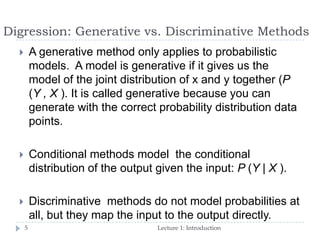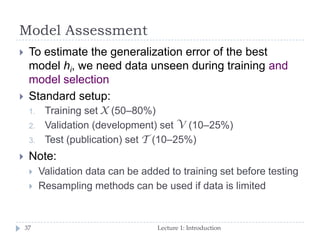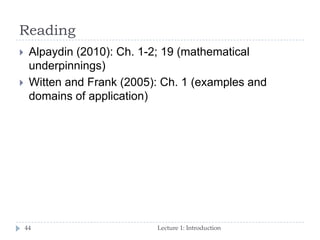Lecture 01: Machine Learning for Language Technology - Introduction
- 1. Lecture 1: Introduction Last updated: 2 Sept 2013 Uppsala University Department of Linguistics and Philology, September 2013 1 Lecture 1: Introduction Machine Learning for Language Technology (Schedule)
- 2. Practical Information Reading list, assignments, exams, etc. Lecture 1: Introduction2 Most slides from previous courses (i.e. from E. Alpaydin and J. Nivre) with adaptations
- 3. Course web pages: Lecture 1: Introduction3 http://stp.lingfil.uu.se/~santinim/ml/ml_fall2013.pdf http://stp.lingfil.uu.se/~santinim/ml/MachineLearning_fall20 13.htm Contact details: [email protected] ([email protected])
- 4. About the Course 4 Introduction to machine learning Focus on methods used in Language Technology and NLP Decision trees and nearest neighbor methods (Lecture 2) Linear models –The Weka ML package (Lectures 3 and 4) Ensemble methods – Structured Predictions (Lectures 5 and 6) Text Mining and Big Data - R and Rapid Miner(Lecture 7) Unsupervised learning (clustering) (Lecture 8, Magnus Rosell) Builds on Statistical Methods in NLPLecture 1: Introduction
- 5. Digression: Generative vs. Discriminative Methods Lecture 1: Introduction5 A generative method only applies to probabilistic models. A model is generative if it gives us the model of the joint distribution of x and y together (P (Y , X ). It is called generative because you can generate with the correct probability distribution data points. Conditional methods model the conditional distribution of the output given the input: P (Y | X ). Discriminative methods do not model probabilities at all, but they map the input to the output directly.
- 6. Compulsory Reading List 6 Main textbooks: 1. Ethem Alpaydin. 2010. Introduction to Machine Learning. Second Edition. MIT Press (free online version) 2. Hal Daumé III. 2012. A Course in Machine Learning (free online version) 3. Ian H. Witten, Eibe Frank Data Mining: Practical Machine Learning Tools and Techniques, Second Edition (free online version) Additional material : 1. Dietterich, T. G. (2000). Ensemble Methods in Machine Learning. In J. Kittler and F. Roli (Ed.) First International Workshop on Multiple Classifier Systems 2. Michael Collins. 2002. Discriminative Training Methods for Hidden Markov Models: Theory and Experiments with Perceptron Algorithms.In Proceedings of the 2002 Conference on Empirical Methods in Natural Language Processing 3. Hanna M. Wallach. 2004. Conditional Random Fields: An Introduction.Technical Report MS-CIS-04-21. Department of Computer and Information Science, University of Pennsylvania. Lecture 1: Introduction
- 7. Optional Reading Lecture 1: Introduction7 Hal Daumé III, John Langford, Daniel Marcu (2005) Search-Based Structured Prediction as Classification. NIPS Workshop on Advances in Structured Learning for Text and Speech Processing (ASLTSP).
- 8. Assignments and Examination 8 Three Assignments: Decision trees and nearest neighbors Perceptron learning Clustering General Info: No lab sessions, supervision by email Reports and Assignments 1 & 2 must be submitted to [email protected] Report and Assignment 3 must be submitted to [email protected] Examination: Written report submitted for each assignment All three assignments necessary to pass the course Grade determined by majority grade on assignments Lecture 1: Introduction
- 9. Practical Organization 9 Marina Santini (1-7); Magnus Rosell (8) 45min + 15 min break Lectures on Course webpage and SlideShare Email all your questions to me: [email protected] Video Recordings of the previous ML course: http://stp.lingfil.uu.se/~nivre/master/ml.html Send me an email, so I make sure that I have all the correct email addresses to [email protected] Lecture 1: Introduction
- 10. Schedule: http://stp.lingfil.uu.se/~santinim/ml/ml_fall2013.pdf Lecture 1: Introduction10
- 11. What is Machine Learning? Introduction to: •Classification •Regression •Supervised Learning •Unsupervised Learning •Reinforcement Learning Lecture 1: Introduction11
- 12. What is Machine Learning Lecture 1: Introduction12 Machine learning is programming computers to optimize a performance criterion for some task using example data or past experience Why learning? No known exact method – vision, speech recognition, robotics, spam filters, etc. Exact method too expensive – statistical physics Task evolves over time – network routing Compare: No need to use machine learning for computing payroll… we just need an algorithm
- 13. Machine Learning – Data Mining – Artificial Intelligence – Statistics Lecture 1: Introduction13 Machine Learning: creation of a model that uses training data or past experience Data Mining: application of learning methods to large datasets (ex. physics, astronomy, biology, etc.) Text mining = machine learning applied to unstructured textual data (ex. sentiment analyisis, social media monitoring, etc. Text Mining, Wikipedia) Artificial intelligence: a model that can adapt to a changing environment. Statistics: Machine learning uses the theory of statistics in building mathematical models, because the core task is making inference from a sample.
- 14. The bio-cognitive analogy Lecture 1: Introduction14 Imagine that a learning algorithm as a single neuron. This neuron receives input from other neurons, one for each input feature. The strength of these inputs are the feature values. Each input has a weight and the neuron simply sums up all the weighted inputs. Based on this sum, the neuron decides whether to “fire” or not. Firing is interpreted as being a positive example and not firing is interpreted as being a negative example.
- 15. Elements of Machine Learning 15 1. Generalization: Generalize from specific examples Based on statistical inference 2. Data: Training data: specific examples to learn from Test data: (new) specific examples to assess performance 3. Models: Theoretical assumptions about the task/domain Parameters that can be inferred from data 4. Algorithms: Learning algorithm: infer model (parameters) from data Inference algorithm: infer predictions from model Lecture 1: Introduction
- 16. Types of Machine Learning Lecture 1: Introduction16 Association Supervised Learning Classification Regression Unsupervised Learning Reinforcement Learning
- 17. Learning Associations Lecture 1: Introduction17 Basket analysis: P (Y | X ) probability that somebody who buys X also buys Y where X and Y are products/services Example: P ( chips | beer ) = 0.7
- 18. Classification Lecture 1: Introduction18 Example: Credit scoring Differentiating between low-risk and high-risk customers from their income and savings Discriminant: IF income > θ1 AND savings > θ2 THEN low-risk ELSE high-risk
- 19. Classification in NLP 19 Binary classification: Spam filtering (spam vs. non-spam) Spelling error detection (error vs. non error) Multiclass classification: Text categorization (news, economy, culture, sport, ...) Named entity classification (person, location, organization, ...) Structured prediction: Part-of-speech tagging (classes = tag sequences) Syntactic parsing (classes = parse trees) Lecture 1: Introduction
- 20. Regression Example: Price of used car x : car attributes y : price y = g (x | q ) g ( ) model, q parameters Lecture 1: Introduction20 y = wx+w0
- 21. Uses of Supervised Learning Prediction of future cases: Use the rule to predict the output for future inputs Knowledge extraction: The rule is easy to understand Compression: The rule is simpler than the data it explains Outlier detection: Exceptions that are not covered by the rule, e.g., fraud 21 Lecture 1: Introduction
- 22. Unsupervised Learning Finding regularities in data No mapping to outputs Clustering: Grouping similar instances Example applications: Customer segmentation in CRM Image compression: Color quantization NLP: Unsupervised text categorization 22 Lecture 1: Introduction
- 23. Reinforcement Learning Learning a policy = sequence of outputs/actions No supervised output but delayed reward Example applications: Game playing Robot in a maze NLP: Dialogue systems, for example: NJFun: A Reinforcement Learning Spoken Dialogue System (http://acl.ldc.upenn.edu/W/W00/W00-0304.pdf) Reinforcement Learning for Spoken Dialogue Systems: Comparing Strengths and Weaknesses for Practical Deployment (http://research.microsoft.com/apps/pubs/default.aspx?id=7029 5) 23 Lecture 1: Introduction
- 24. Supervised Learning Introduction to: •Margin •Noise •Bias Lecture 1: Introduction24
- 25. Supervised Classification Lecture 1: Introduction25 Learning the class C of a “family car” from examples Prediction: Is car x a family car? Knowledge extraction: What do people expect from a family car? Output (labels): Positive (+) and negative (–) examples Input representation (features): x1: price, x2 : engine power
- 26. Training set X X {xt ,rt }t1 N r 1 if x is positive 0 if x is negative Lecture 1: Introduction 26 x x1 x2
- 27. Hypothesis class H Lecture 1: Introduction27 p1 price p2 AND e1 engine power e2
- 28. Empirical (training) error Lecture 1: Introduction28 h(x) 1 if h says x is positive 0 if h says x is negative E(h | X) 1 h xt rt t1 N Empirical error of h on X:
- 29. S, G, and the Version Space Lecture 1: Introduction29 most specific hypothesis, S most general hypothesis, G h H, between S and G is consistent [E( h | X) = 0] and make up the version space
- 30. Margin Lecture 1: Introduction30 Choose h with largest margin
- 31. Noise Lecture 1: Introduction31 Unwanted anomaly in data Imprecision in input attributes Errors in labeling data points Hidden attributes (relative to H) Consequence: No h in H may be consistent!
- 32. Noise and Model Complexity Lecture 1: Introduction32 Arguments for simpler model (Occam’s razor principle) 1. Easier to make predictions 2. Easier to train (fewer parameters) 3. Easier to understand 4. Generalizes better (if data is noisy)
- 33. Inductive Bias Lecture 1: Introduction33 Learning is an ill-posed problem Training data is never sufficient to find a unique solution There are always infinitely many consistent hypotheses We need an inductive bias: Assumptions that entail a unique h for a training set X 1. Hypothesis class H – axis-aligned rectangles 2. Learning algorithm – find consistent hypothesis with max- margin 3. Hyperparameters – trade-off between training error and margin
- 34. Model Selection and Generalization Lecture 1: Introduction34 Generalization – how well a model performs on new data Overfitting: H more complex than C Underfitting: H less complex than C
- 35. Triple Trade-Off Lecture 1: Introduction35 Trade-off between three factors: 1. Complexity of H, c(H) 2. Training set size N 3. Generalization error E on new data Dependencies: As N E As c(H) first E and then E
- 36. Model Selection Generalization Error Lecture 1: Introduction36 To estimate generalization error, we need data unseen during training: Given models (hypotheses) h1, ..., hk induced from the training set X, we can use E(hi | V ) to select the model hi with the smallest generalization error ˆE E(h |V) 1 h xt rt t1 M V {xt ,rt }t1 M X
- 37. Model Assessment Lecture 1: Introduction37 To estimate the generalization error of the best model hi, we need data unseen during training and model selection Standard setup: 1. Training set X (50–80%) 2. Validation (development) set V (10–25%) 3. Test (publication) set T (10–25%) Note: Validation data can be added to training set before testing Resampling methods can be used if data is limited
- 38. Cross-Validation Lecture 1: Introduction38 121 31 2 2 2 32 1 1 1 K K K K K K XXXTXV XXXTXV XXXTXV K-fold cross-validation: Divide X into X1, ..., XK Note: Generalization error estimated by means across K folds Training sets for different folds share K–2 parts Separate test set must be maintained for model assessment
- 39. Bootstrapping Lecture 1: Introduction39 3680 1 1 1 . e N N Generate new training sets of size N from X by random sampling with replacement Use original training set as validation set (V = X ) Probability that we do not pick an instance after N draws that is, only 36.8% of instances are new!
- 40. Measuring Error Lecture 1: Introduction40 Error rate = # of errors / # of instances = (FP+FN) / N Accuracy = # of correct / # of instances = (TP+TN) / N Recall = # of found positives / # of positives = TP / (TP+FN) Precision = # of found positives / # of found = TP / (TP+FP)
- 41. Statistical Inference 41 Interval estimation to quantify the precision of our measurements Hypothesis testing to assess whether differences between models are statistically significant m 1.96 N e01 e10 1 2 e01 e10 ~ X1 2 Lecture 1: Introduction
- 42. Supervised Learning – Summary 42 Training data + learner hypothesis Learner incorporates inductive bias Test data + hypothesis estimated generalization Test data must be unseen Next lectures: Different learners in LT with different inductive biases Lecture 1: Introduction
- 43. Anatomy of a Supervised Learner (Dimensions of a supervised machine learning algorithm) Model: Loss function: Optimization procedure: g x |q E q | X L rt ,g xt |q t Lecture 1: Introduction43 q* arg min q E q | X
- 44. Reading Lecture 1: Introduction44 Alpaydin (2010): Ch. 1-2; 19 (mathematical underpinnings) Witten and Frank (2005): Ch. 1 (examples and domains of application)
- 45. End of Lecture 1 Thanks for your attention Lecture 1: Introduction45
Editor's Notes
- #10: To





























![S, G, and the Version Space
Lecture 1: Introduction29
most specific hypothesis, S
most general hypothesis, G
h H, between S and G
is consistent [E( h | X) =
0] and make up the
version space](https://image.slidesharecdn.com/lecture01ml4ltmarinasantini2013-130823073149-phpapp02/85/Lecture-01-Machine-Learning-for-Language-Technology-Introduction-29-320.jpg)















